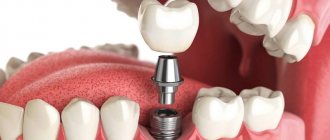All patients strive to spend as little time as possible in the dentist's chair, regardless of what manipulations the doctor performs. But, if we are talking about such an operation as the introduction of an artificial root into the jawbone, questions about the timing are asked especially often. Many people, even at the initial consultation stage, are interested in how long it takes to place a dental implant, believing that such a procedure lasts a long time.
Before answering this question, let us briefly dwell on the actions that a dental surgeon performs during such an intervention.
What manipulations are performed when installing an implant?
The main steps when using the classical technique:
- Introduction of an anesthetic drug.
- Cutting the gums and peeling off the mucoperiosteal flap.
- Formation of the bone bed, with its gradual expansion until the desired size is achieved.
- Periodic irrigation of tissues to prevent overheating of the bone.
- Screwing a metal implant into the hole and installing a plug.
- Placement of mucoperiosteal flaps and suturing.
How is the treatment carried out?
The doctor uses special tools to drill a hole in the head of the unit being restored. Through it, it removes diseased pulp and dentin, and also disinfects the outlet space, and then seals it.
There are two main processing methods:
- apical-coronal, i.e. the doctor processes the dental canal from top to bottom, from the head to the mouth of the root;
- coronal-apical, i.e. on the contrary - from bottom to top.
The key to a high-quality procedure is accurate diagnosis of the roots, which is ensured by radiography. The picture is taken before, during and after the procedure. This is necessary in order to assess the length and shape of the dental outlet as accurately as possible. After all, these indicators are individual for each person.
During the procedure, antimicrobial agents are used that have the following effects:
- destroy harmful microflora;
- improve the condition of the preserved tissues of the unit;
- do not cause allergic reactions.
Our clinic actively uses laser technologies, which give excellent results.
They carefully remove dead remains of pulp and dentin without damaging living tissue.
Leave your phone number. The clinic administrator will call you back.
By leaving a request on the site, you consent to the processing of personal data
Make an appointment
Initial consultation
400 rubles
The image shows poorly treated root canals in the lower sixth unit.
BEFORE AFTER
BEFORE AFTER
How long does it take to install a dental implant?
The above manipulations take a total of about 25–35 minutes. But in complicated cases, implant installation is somewhat delayed and can last 40–50 minutes or even an hour.
Also, the operation takes longer if additional combined manipulations are performed. For example, the bottom of the nasal sinus is raised to increase the space for the implant.
The duration of the operation may also increase if the dentist does not yet have much experience in performing such interventions. A highly qualified specialist who has been successfully installing implants for a long time does it quite quickly.
Content
- When to remove a nerve
- What to do before visiting the doctor
- How to remove a dental nerve
- How long does it take to remove a nerve?
- Is it painful to remove a nerve?
- Recommendations for care after removal
- Prevention of dental diseases
Each tooth has a pulp in which blood, lymphatic vessels and nerve endings are intertwined. This system is designed to protect the tooth, provide it with nutrition, blood and minerals. After removing the nerve (pulp), the nutrition of the tooth stops, as a result of which it loses some of its properties and will deteriorate faster. If caries is in its initial stage and does not affect the pulp, dental treatment does not involve its removal.
What are the fastest ways to install an implant?
Three modern methods of dental implantation require the least amount of time:
- One-step. A single-rooted tooth that cannot be restored can be quickly removed and replaced with an implant and crown. In this case, the rod is screwed into a ready-made hole. Therefore, such an operation can take only 15 minutes.
- According to the template. A navigation surgical template helps reduce the time of implant installation. This is a plastic structure with guide holes. Through them, the dentist prepares a bed for the implant, for which mills with depth limiters are used. The screw rods are quickly screwed into the prepared holes. Since the gums are not cut or sutured, installation of one element takes no more than 20–25 minutes.
- Express implantation. Implants are installed quickly also using one-stage All on 4(6) protocols. The rods are screwed into the bone through the gums, without any soft tissue incisions. Only small punctures are made through which the dentist inserts implants into the jaw. This operation takes from one and a half to two to three hours, depending on the number of rods being installed.
When installing an implant, it is not the duration of the operation that is important, but the quality. If the doctor has the appropriate qualifications, experience, is not in a hurry and does everything in accordance with the protocol, the procedure takes exactly as long as necessary.
How long does it take to treat caries?
Very often you can hear the question: “how long will the treatment take?” It is difficult to give a definite answer, because a huge number of factors influence the duration of treatment.
So what can affect treatment time?
Let's sort it out in order.
The first step is pain relief . Anesthesia for the treatment of teeth in the upper jaw occurs quickly and quite well, it takes about
5 minutes (application anesthesia, the so-called “jam”, occurs within 1-2 minutes, then direct infiltration anesthesia, in which the administration of the anesthetic takes 1 minute and waits for the onset of the anesthesia effect for about 2-3 minutes).
And when treating lower jaw teeth, difficulties with pain relief may arise, which is due to anatomical features.
Often, infiltration anesthesia alone is not enough, and it is necessary to resort to conduction anesthesia.
Its effect develops on average within 5-7 minutes, but there are cases (rather rarely) when you have to wait up to 30 minutes. This depends on the individual characteristics of the patient.
Degree of mouth opening and access to tooth.
This is the next factor that influences the duration of treatment. There are a number of patients with limited mouth opening and pathology of the temporomandibular joint. Also, molars (the very last teeth) have a complex arrangement. All of this can increase the time required for treatment.
The fundamental factor is the degree of tooth decay .
This refers to the depth of the carious process (caries can be superficial, medium and deep), as well as the number of affected tooth walls.
The deeper the cavity, the longer it takes to remove the entire carious process and preserve the tooth tissue as much as possible.
If the contact surfaces are affected or, for example, caries is located under the gum, this also increases the duration of treatment, since it is necessary to install a matrix system and restore the physiological contact point.
The time of preparation of the carious cavity and its restoration depend on these factors. Preparation time can take from 5 to 20 minutes, and the restoration itself can take from 10-40 minutes.
Creating a high-quality restoration takes a sufficient amount of time, which is associated with performing certain manipulations:
- high-quality insulation (use of rubber dam),
- use of optics (microscope or binoculars),
- installation of a matrix system and its adaptation to recreate a dense physiological contact point;
- stage of conditioning with a special gel to create micro-spaces,
- compliance with the technique of introducing the adhesive system (adhesive is a kind of “glue” that firmly connects the filling material to the tooth tissues),
- layer-by-layer application of filling material, its adaptation and polymerization, formation of anatomical formations (tubercles, fissures),
- polishing the restoration.
Compliance with all stages affects the quality and service life of the restoration.
To summarize, we can say that on average, caries treatment time can take from 30 minutes to 1.5 hours.
At Belaya Medvetsa, we pay great attention to the quality of the treatment, which requires a certain time to perform all the necessary manipulations according to the treatment protocol, and as a result, obtain a functional restoration that will repeat the anatomical shape of a natural tooth.
And finally, let's look at a few clinical cases.
Clinical case 1:
Objectively: on the chewing surface of the 17th tooth there is a carious cavity of medium depth.
The treatment of this tooth took 30 minutes.
Clinical case 2:
Objectively: on the chewing surface of the 36th tooth there is a filling with a defect in the marginal fit, on the contact surfaces there are carious cavities of medium depth. There is also a carious cavity on the distal surface of the 35th tooth.
In this case, the treatment time was 1.5 hours.
Indications for dental canal treatment
Tooth canal treatment is a specific dental procedure that is advisable to perform in the following clinical cases:
When an active inflammatory process is detected inside the root of a dental unit. The inflammatory process in this part of the tooth can lead to gradual tissue necrosis. If tissue necrosis begins, the diseased tooth will have to be removed.
The condition is diagnosed by radiography;
Treatment of tooth canals is required for pulpitis - inflammation affecting the pulp bundle;
Endodontic treatment is carried out for periodontitis, a disease affecting the apical part of the tooth root;
In some cases, cleaning and treatment of dental canals is required for advanced forms of caries.
Dental canal treatment is also indicated for abscesses, the onset of an inflammatory process under an old filling, or a fractured tooth root. The need for measures to treat tooth canals may be indicated by such symptoms as: severe, excruciating pain in the tooth, occurring mainly at night, swelling of soft tissues, discoloration of the gums and tooth enamel.
In some cases, tooth canal treatment is carried out before prosthetics. The nerve is removed from the tooth, and the canal cavities are cleaned, treated with antiseptic drugs and filled.
Wisdom tooth removal
Wisdom teeth are considered full-fledged elements of the oral cavity. They are involved in chewing food (if they are located above each other and have contact), and can act as a support for bridges and removable dentures in the future. There are specific indications for extraction in their case. For this reason, the decision about whether wisdom teeth need to be removed is made only by the attending physician.
The most common problem with eighth teeth is their growth. Only some teeth form and grow completely without complications, but often these processes are accompanied by a number of difficulties:
- semi-retinated or impacted elements that have formed in the bone tissue, but have not erupted or only partially erupted. Their position can be vertical, horizontal, or with their roots outward. Because of this, neighboring elements suffer, constant pain appears;
- violation of position (dystopia). Since wisdom teeth erupt without predecessors (baby teeth), and the jaw bone is already formed and does not develop, the position of the elements is often incorrect. They injure the mucous membrane, overlap other crowns, and put pressure on neighbors. This leads to inflammation. The doctor will determine whether the position can be restored with orthodontic treatment or whether it is better to remove the wisdom tooth;
- appearance of a gingival hood. When slowly cutting through the mucosa, an area is formed in which bacteria and food debris accumulate, which are difficult to clean. This leads to acute inflammation, which can provoke the appearance of pus;
- destruction, caries. Elements may appear immediately underdeveloped with carious lesions.
The doctor determines whether wisdom teeth should be removed or not based on complaints and the clinical picture. Problems with even one or two teeth interfere with the normal functioning of the entire dental system. Pain appears when opening the mouth and chewing. The bite and position of the incisors may even change.
How a wisdom tooth is removed depends, as in the case of permanent elements, on the condition of the dental system. In the absence of contraindications, manipulation is carried out with ordinary forceps.
Whether it is painful to remove a wisdom tooth depends on the presence or absence of purulent formations. If they are present, then the painful sensations may persist even after pain relief. Most often, classical infiltration anesthesia is used, which covers a large area and maintains the effect for a long time.
Is it painful to remove a nerve from a tooth?
Modern dentistry has the widest possibilities and powerful universal anesthesia. Thanks to this, removal of the flock nerve is a painless procedure that is carried out during the visit. The only discomfort that the patient may feel concerns the injection into the gum. This can also be easily avoided by applying anesthesia, after which inserting a needle will not cause any discomfort.
Pain may occur in rare cases for one of the following reasons:
- Individual characteristics of the path of nerves, which is why standard techniques provide insufficient pain relief.
- Taking painkillers the day before by the patient, in particular from the group of non-steroidal anti-inflammatory drugs (NSAIDs), may reduce the effectiveness of anesthesia.
- The patient took alcohol before visiting the doctor.
- The patient belongs to the 2% of all people with immunity to anesthetics.
The solution to the problem in each case is the same - repeated anesthesia.
Stages of dental prosthetics
Dental prosthetics consists of several stages.
- Preparation. Includes consultation with a doctor, diagnosis, and treatment of dental diseases.
- Manufacturing of orthopedic structures in a dental laboratory (Stompraktika has its own laboratory equipped with the latest technology).
- Trying on the finished design and adjusting it (if necessary).
What to do after prosthetics?
Caring for fixed orthopedic structures is no different from caring for your own teeth: brush your teeth morning and evening, and rinse your mouth after every meal. If the design is removable and you do not use gel for fixation, then do not forget to wash it after eating. If the removable denture is fixed on the gel, then it is enough to rinse your mouth. Also, twice a week, removable dentures must be cleaned using special tablets. Your doctor will give you a complete list of recommendations.
Pulp - what is it for?
The pulp is a fibrous connective tissue penetrated by nerve endings and blood vessels.
Its shape completely follows the tooth, and is located in the center of the root part, filling the entire cavity. On top, the pulp is protected by a hard enamel layer, which prevents injury from the outside.
Main functions of the dental nerve:
- responsible for the formation, proper growth of teeth and blood supply;
- protects channels from pathogenic microbes;
- supplies the tooth with useful micro- and macroelements.
In addition, the pulp is responsible for the sensitivity of the tooth, that is, for its reaction upon contact with hot, cold, sour, sweet, and so on.
Reference! The dental pulp in adults is thinner than in children. This is due to age-related changes and a slowdown in regeneration processes. The older a person is, the thinner and weaker the nerve becomes, and the tooth begins to experience a deficiency of nutrients.









